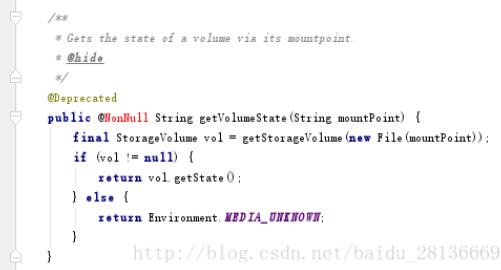Android获得所有存储设备位置 Android获得所有存储设备位置的最佳方法
徒步青云 人气:0本方式可以获得内部存储设备地址、SD卡地址、USB设备地址,兼容性能达到99%(别问我为什么这么保证,因为是借鉴了Android设置->存储页面的源码)。
由于调用了几个被@hide的方法,所以采用了反射。
具体代码如下:
public static List<HomeDirBean> getAllExternalStorage(Context context) {
List<HomeDirBean> storagePath = new ArrayList<>();
StorageManager storageManager = (StorageManager) context.getSystemService(STORAGE_SERVICE);
StorageVolume[] storageVolumes;
try {
Method getVolumeList = StorageManager.class.getDeclaredMethod("getVolumeList");
storageVolumes = (StorageVolume[]) getVolumeList.invoke(storageManager);
Method getVolumeState = StorageManager.class.getDeclaredMethod("getVolumeState", String.class);
for (StorageVolume storageVolume : storageVolumes) {
String desc = storageVolume.getDescription(context);
Log.i(TAG, "storageVolume name--->" + desc);
Method getPath = StorageVolume.class.getMethod("getPath");
String path = (String) getPath.invoke(storageVolume);
Log.i(TAG, "StoragePath--->" + path);
//这里需要用StorageManager反射调用getVolumeState函数,而不应该用StorageVolume的getState方法,因为可能会报错
String state = (String) getVolumeState.invoke(storageManager, path);
Log.i(TAG, "storageVolume State--->" + state);
if (Environment.MEDIA_MOUNTED.equals(state)) {
HomeDirBean bean = new HomeDirBean(path, desc);
storagePath.add(bean);
}
}
} catch (Exception e) {
Log.e(TAG, e.getMessage());
}
return storagePath;
}
这里需要注意,可能有小伙伴会问,既然StorageVolume类有getState方法,为啥还要用StorageManager反射调用getVolumeState方法,并传入path地址,而在源码里,StorageManager的getVolumeState的方法的实现,也是将path重新创建为StorageVolume类,然后再调用其getState方法,我们这样做成这不是多此一举吗?
源码截图如下:

答案当然不是了,不然我也不会放弃性能去反射那个方法去装这个逼了。主要原因是@hide的这个方法里,mountPoint被重新打包成StorageVolume时,这相当于系统去创建的一个StorageVolume实例,自然可以执行它的所有方法。而如果是应用直接调用,在被打包时,很多方法被隐藏了,比如这个getState方法,这时候应用就会报错,找不到该方法。
先简单写到这,以后有补充再添加。
以上这篇Android获得所有存储设备位置的最佳方法就是小编分享给大家的全部内容了,希望能给大家一个参考,也希望大家多多支持。
加载全部内容